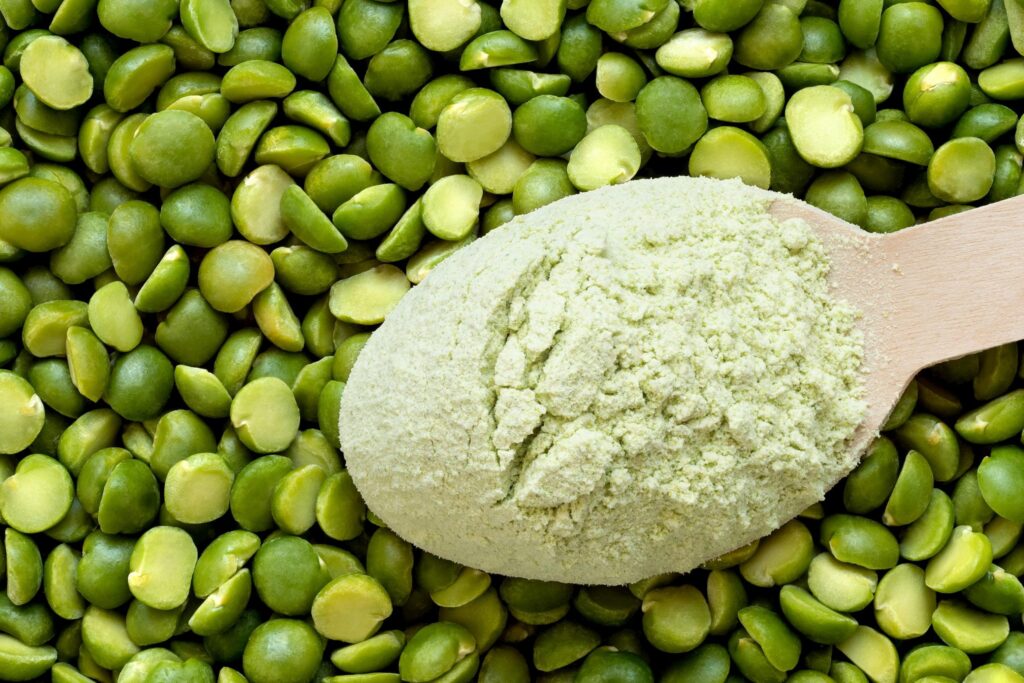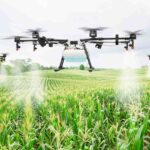

What Is Pea Protein?
Pea protein is a food additive with a neutral taste that is used in dairy alternatives such as cheeses and yogurt. It is extracted from the yellow pea, Pisum sativum, and has a typical legume amino acid profile.
Peas are a member of the legume family, which includes many well-known sources of vegetable protein. For generations, soy protein has been a major ingredient in protein powder supplements, but in recent years, pea protein has come to take centre stage. When marketers refer to “pea protein”, they are referring to green or yellow peas (pisum sativum). If you have ever made split pea soup or Indian dal, the dried split peas you used are the raw materials for making pea protein based powders.
Health Benefits of Pea Protein

Pea protein is said to be one of the most perfect proteins for human consumption. Its benefits over both animal and other vegetable proteins include:
● Ease of digestion.
● Lack of allergens.
● Ideal amino acids for sports.
Some users find soy and other sources of protein difficult to digest, but because of its unique composition, pisum sativum has been found to be amongst the most digestible source of protein available. Soy, whey, egg and animal-based protein supplements have all been shown to produce allergic reactions in some people and their potential for allergic reactions can increase with repeated use. Of all the protein supplements available, pea proteins have been shown to produce the least allergic reactions.
Perhaps most importantly for sports enthusiasts, pea protein contains an ideal combination of essential amino acids for sports performance:
● Lysine, for balanced nitrogen levels in muscles.
● Arginine promotes muscle metabolism and a healthy heart.
● Glutamine helps restore nitrogen balance after a heavy workout.
● Leucine, isoleucine and valine (branched-chain amino acids) help maintain tissues during exercise.
Pea Protein May Help Prevent Kidney Disease
According to a 2009 Canadian study reported in Medical News Today, peas may be an effective way to fight high blood pressure and kidney disease. According to the article, incidences of chronic kidney disease (CKD), which often leads to drastic treatments such as kidney dialysis or kidney transplant, has increased at an alarming rate since the 1990s.
High blood pressure is an aspect of CKD that leads to a host of serious diseases, including heart disease. High blood pressure and kidney disease is a “two way street”: work or lifestyle induced hypertension leads to high blood pressure, which in turn leads to kidney disease. In turn, kidney disease leads to high blood pressure. Since pea protein helps lower high blood pressure as well as seems to help the kidneys flush out toxins, it has both preventive and treatment potential.
Interestingly, the researchers found that pea protein extracts were of more value than natural peas because of the enzymes that are used in the protein extraction process. Whether or not the pea proteins used in health supplements undergo the same process was not stated in the article cited above, but the general health benefits of pea protein, both natural and in powdered form, are uncontested.
Natural Peas or Pea Protein Powders?
Of course, manufacturers of pea protein supplements tout the benefits of their products, but what about plain old garden variety peas? According to studies, the boiled green peas that parents encourage their children to eat (sometimes in vain) contain 8 grams of protein, very low levels of fat, high levels of essential vitamins and minerals and over 50 percent of the recommended daily allowance of potassium. Pea protein powders have the advantages of even higher levels of protein and because of the way they are processed, do not produce flatulence.
If there is a down side to pea protein supplements, it is that there is such a thing as too much protein. Excessively high protein intake can lead to a build up of uric acid in the system, which causes gout, a painful inflammatory disease that affects the joints. It can also lead to the leeching of calcium from the bones, which can have severe long term consequences. For these reasons, before commencing any radical changes to your diet, you should always consult a qualified nutritionist.
INTRODUCTION PROTEIN,, FROM THE GREEK “PROTOS” (FIRST / AT THE ORIGIN)..
Proteins made possible the first biochemical reactions in living cells, at the origin of
life.
Proteins are required for the structure, function, and regulation of the body’s cells,
tissues, and organs; each protein has unique functions. Examples are hormones,
enzymes and antibodies.
PEA, one of the oldest sources of food in Europe, combines energy from starch and
protein, for human nutrition.
With NUTRALYS® PEA protein, ROQUETTE opens a new future for PEA by offering
a large number of formulation opportunities.
Pea Starch and Pea Protein
Whilst other legumes like soy or lupines are key for obtaining proteins, the pea is also an important source of starch. GEA Westfalia Separator Group supports the wet process used to obtain both valuable substances, starch and protein, in a single process.
Contents
· First extraction stage: Obtaining proteins
· Second extraction stage: Obtaining starch
Process line at a glance
In addition to decanters for extraction and dewatering, 3-phase nozzle separators and clarifiers are used, so this process reflects the company‘s full range of products.
Integrated process line from GEA Westfalia Separator Group for obtaining pea starch and pea protein  First extraction stage: Obtaining proteins The cleaned peas are steeped in caustic soda, split open and then fed into a double extraction stage. As early as the first extraction stage, the decanter separates a pure protein liquid from which the proteins are precipitated in bypass with the aid of acid and heat. In order to achieve as high as possible a yield of pea protein, the precipitated proteins first pass through a decanter for dewatering and then through a clarifier. The dewatered protein goes straight to drying. Second extraction stage: Obtaining starch Before the pea starch can be washed in the main stream, the coarser plant fibers still need to be extracted. Nothing is wasted here either – the coarser fibers from extraction are dewatered and dried by a decanter so that they can be traded as a by-product, just like the fine fibers separated out of the first washing stage. The latest-generation 3-phase nozzle separators are used for the 3-stage washing process. The raw starch milk is finally dewatered and dried by a decanter. First extraction stage: Obtaining proteins The cleaned peas are steeped in caustic soda, split open and then fed into a double extraction stage. As early as the first extraction stage, the decanter separates a pure protein liquid from which the proteins are precipitated in bypass with the aid of acid and heat. In order to achieve as high as possible a yield of pea protein, the precipitated proteins first pass through a decanter for dewatering and then through a clarifier. The dewatered protein goes straight to drying. Second extraction stage: Obtaining starch Before the pea starch can be washed in the main stream, the coarser plant fibers still need to be extracted. Nothing is wasted here either – the coarser fibers from extraction are dewatered and dried by a decanter so that they can be traded as a by-product, just like the fine fibers separated out of the first washing stage. The latest-generation 3-phase nozzle separators are used for the 3-stage washing process. The raw starch milk is finally dewatered and dried by a decanter. |
WHAT’S SO GOOD ABOUT PEAS?
Peas are legumes, which are good sources of protein and fibre and low in fat. Pea protein is not made from green peas, which are probably the most popular variety eaten by westerners, but yellow peas, which are also known as split peas. Yellow peas are widely grown in Canada and China but Roquette uses crops harvested within 200 km of its French factory for its pea protein, which is called Nutralys® pea protein. France is also among the leading countries producing yellow pea (leader in EU).
WHY USE VEGETABLE PROTEIN INGREDIENTS?
ROLE OF PROTEIN
Proteins, of both animal and vegetable origin, are key constituents of our food.
Human needs increase with age
ƒ 0.83 g / kg of bodyweight / day for adults
ƒ 1 g / kg of bodyweight / day for seniors
and activity (at least 1.3 g / kg of body weight / day for sportsmen and women).
Among food ingredients proteins are one of the fastest growing segments, as they
ally nutritional and functional benefits.
VEGETABLE PROTEIN AS AN INGREDIENT
Vegetable proteins are food ingredients derived from various vegetable species that
are rich in proteins, such as cereals and legumes (vegetable whose fruit is a pod).
They offer excellent quality to the food industry thanks to a low level of lipids, which
confers an attractive nutritional profile in line with WHO recommendation for obesity
and Cardio Vascular Disease (CVD) prevention.
WHO and the Health Ministries of Western Countries recommend increasing the
proportion of vegetables in our food.
OTHER HEALTH BENEFITS
Long-term over-reliance on large quantities of animal proteins may increase cholesterol levels and the possible risk of heart disease. Vegetable foods are low in saturated fat and cholesterol and a good source of unsaturated fat, fibre, vitamins and minerals. Yellow peas used for pea protein are also low in phytosteroids, (conversely to soybean), which minimises possible oestrogenic effects.
SPEED OF RELEASE
Pea protein is digested slower than whey protein but faster than casein. Its intermediate speed of digestion provides another option when deciding how quickly you want to feed your muscles.
PRICE
Peas have not been subject to all of the commercial pressures that have driven up the price of whey in recent years. Although prices vary according to brands, pea protein generally costs less than animal protein.
SUSTAINABILITY
Environmental factors are increasingly influencing consumer behaviour. As an example, the land requirements for the production of animal proteins are five times greater than for plant-based proteins, which makes it a more sustainable product. Animal farming can also contribute to deforestation. Pea is a legume, and as such is able to utilise nitrogen for growth.
Therefore, it does not require harmful nitrogen fertilisers. The fact that Roquette sources peas from within 200 km of its factory also reduces also its carbon footprint. Generally speaking, the carbon footprint of plant protein production is significantly lower than animal protein.


